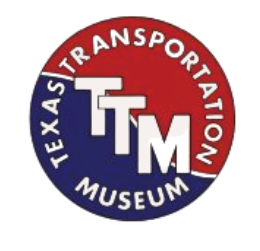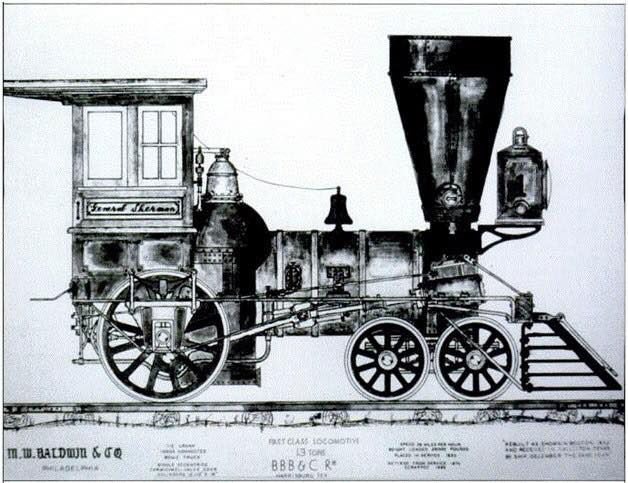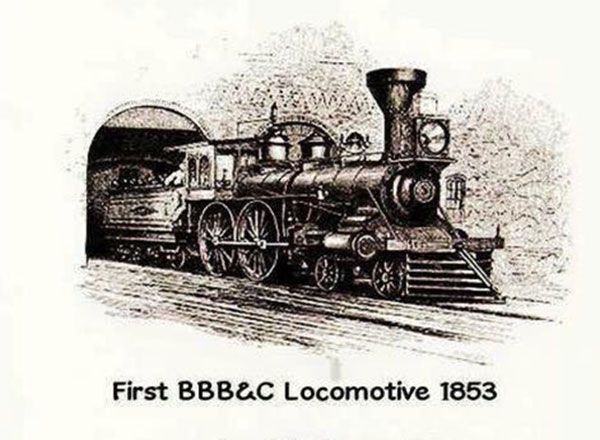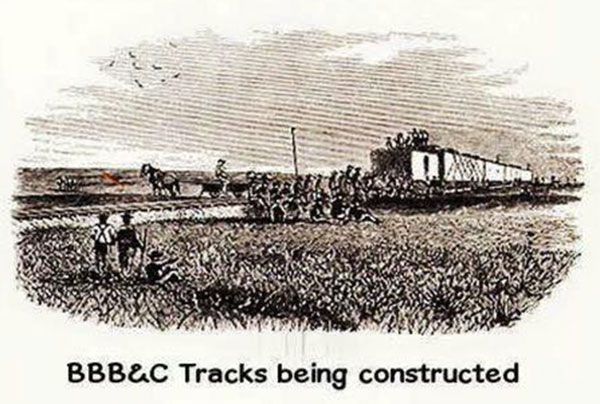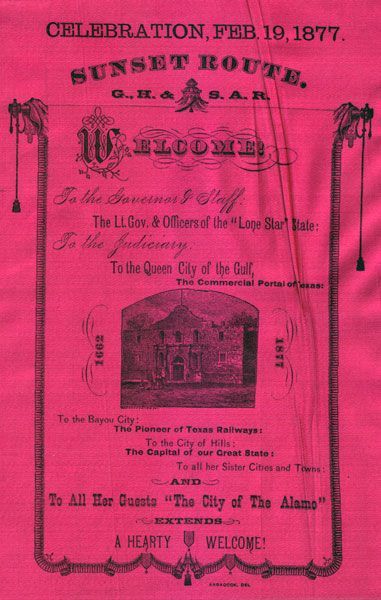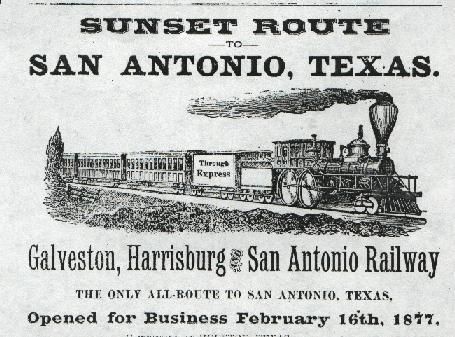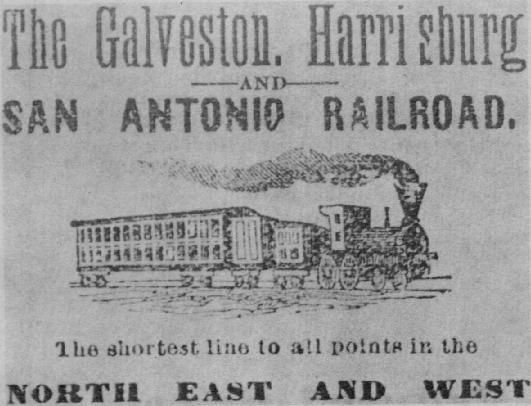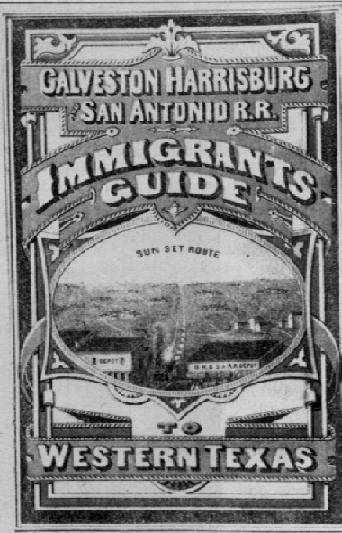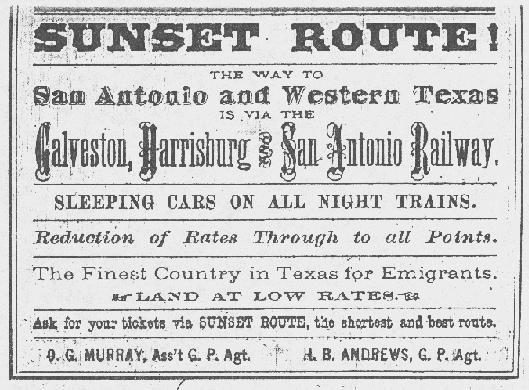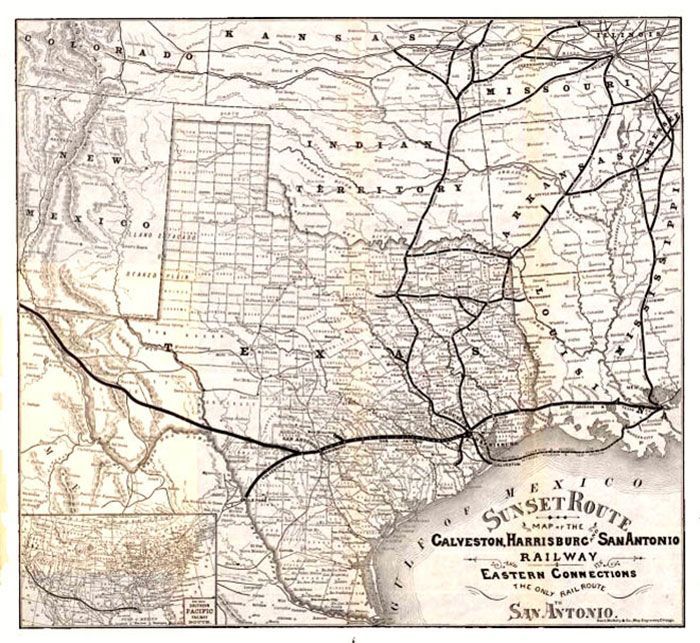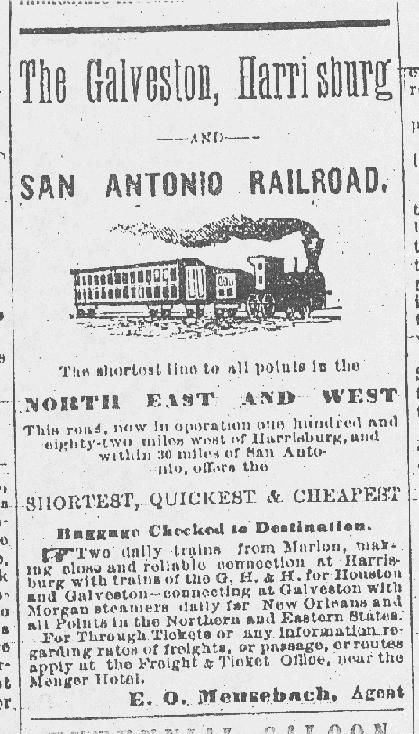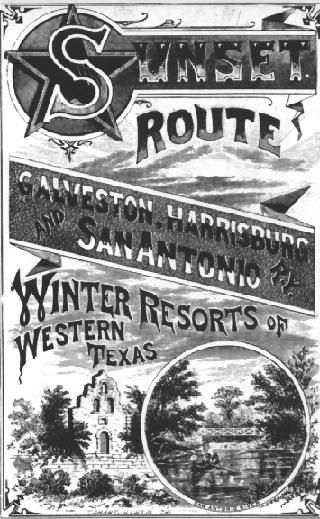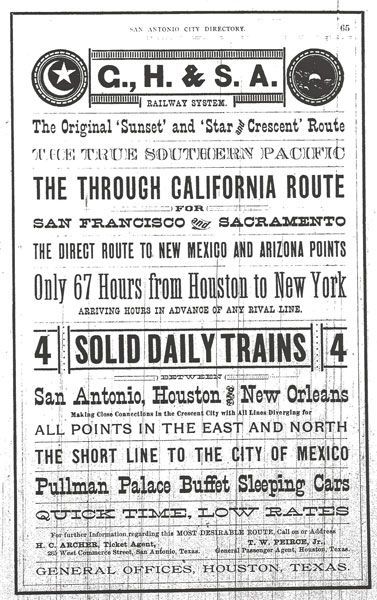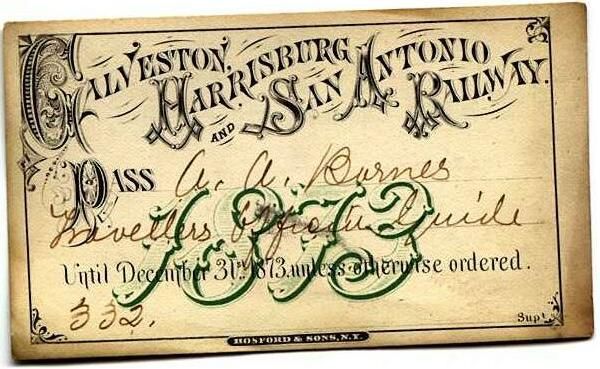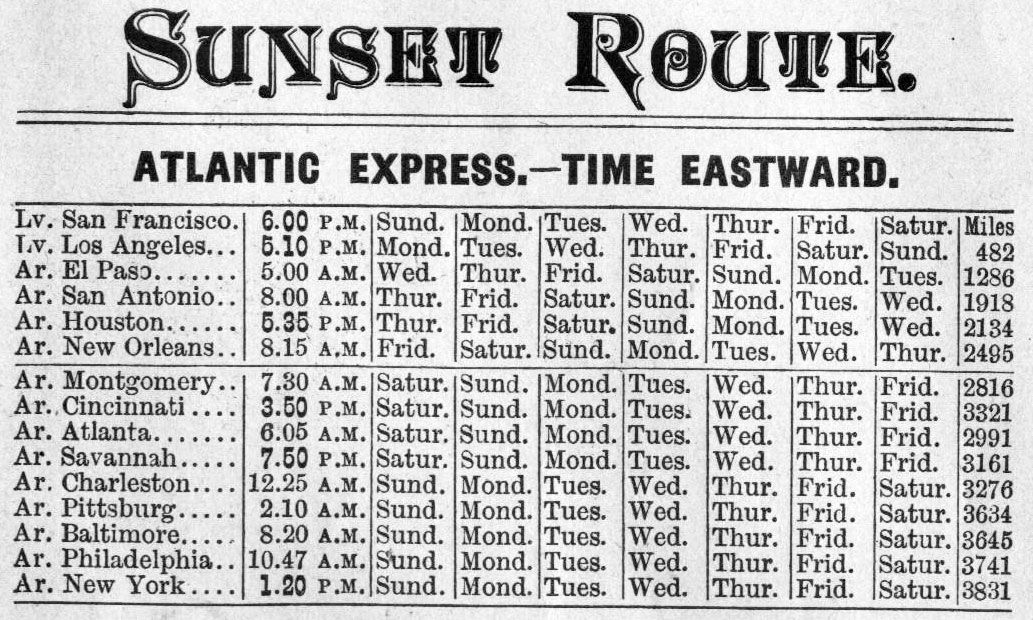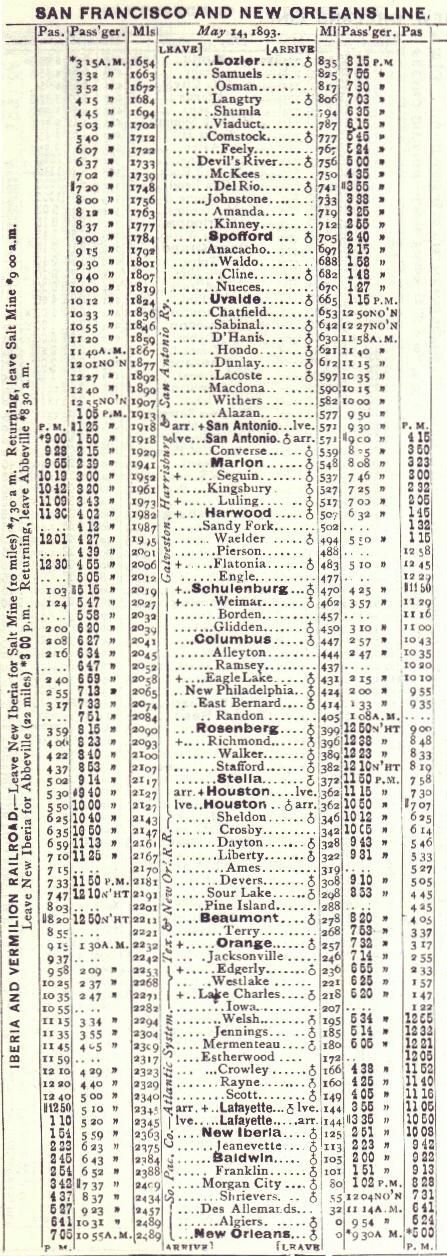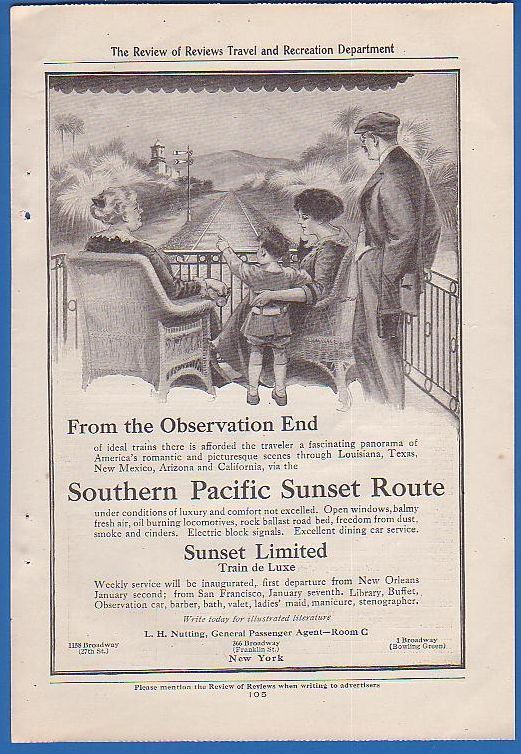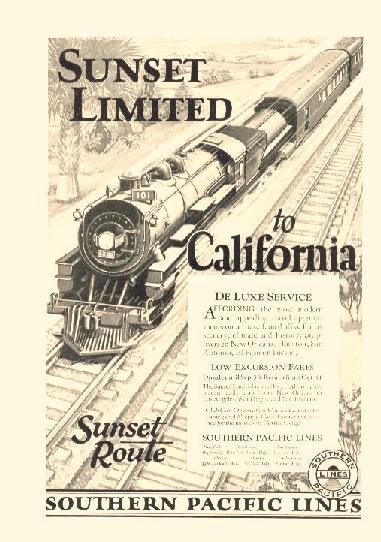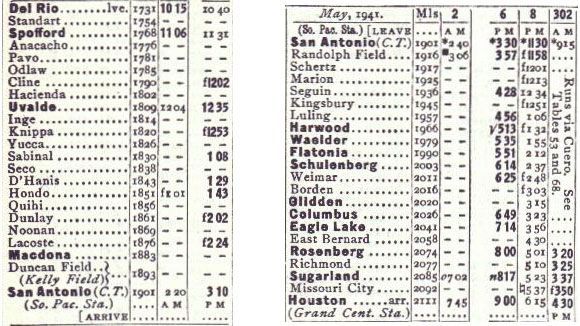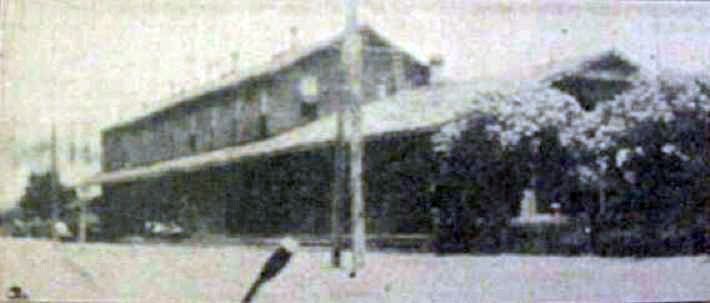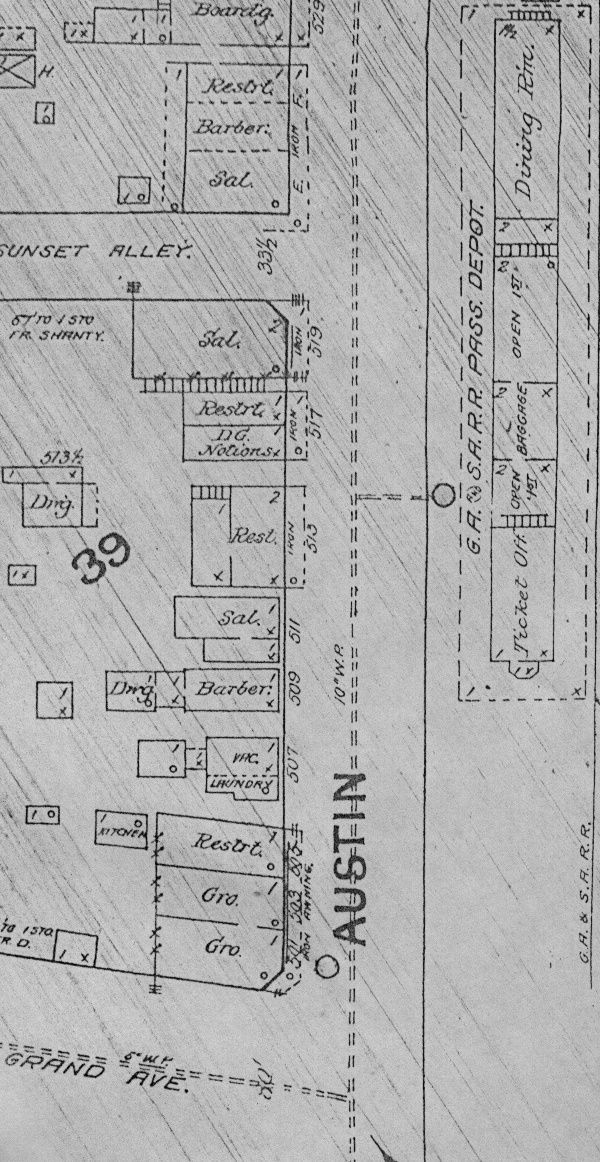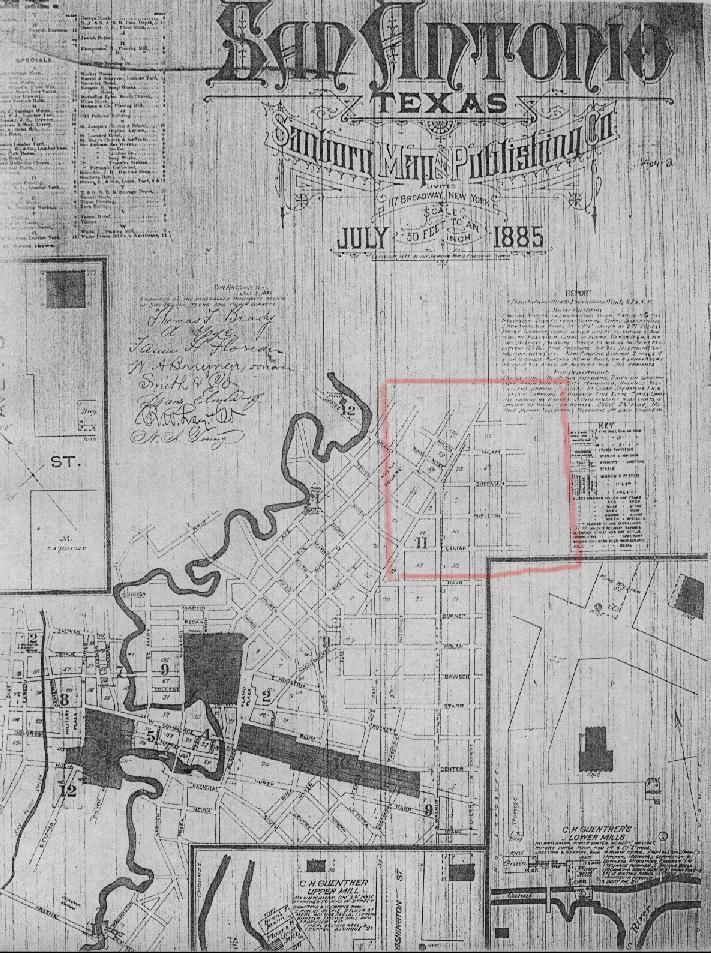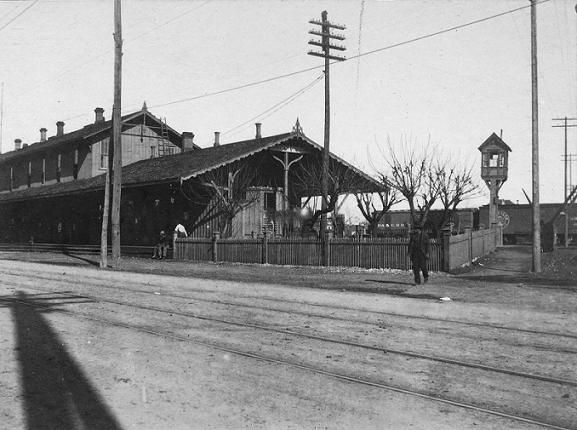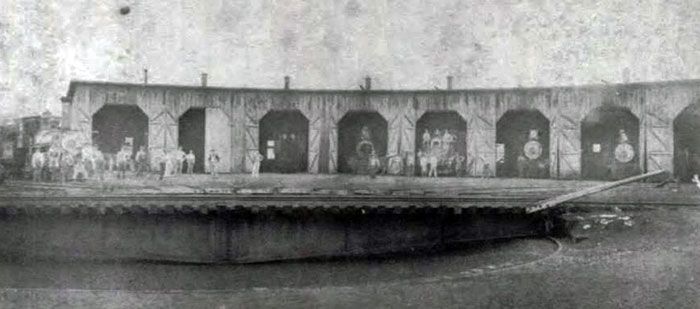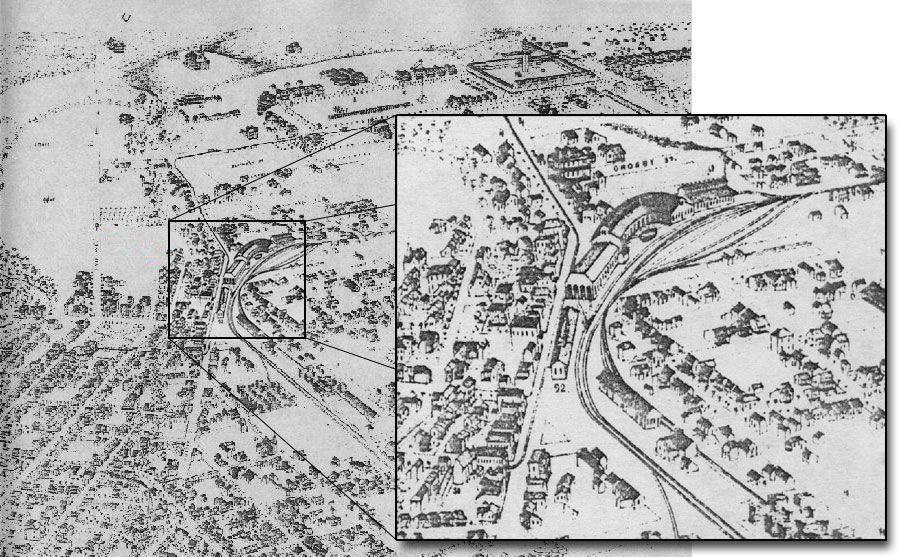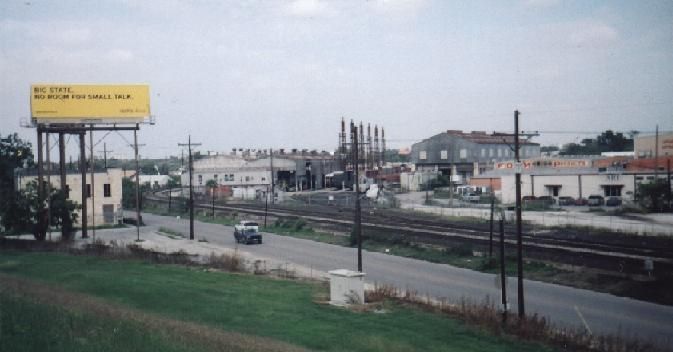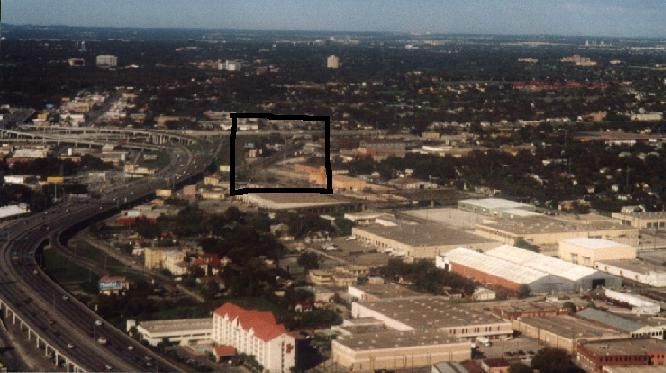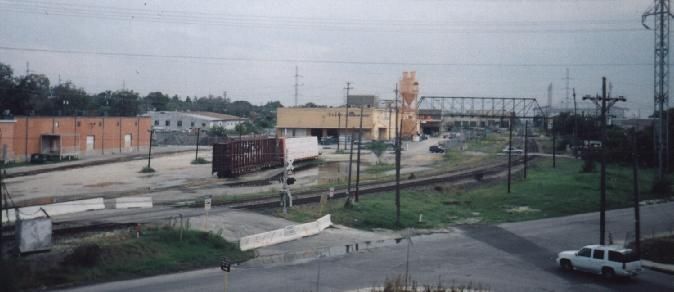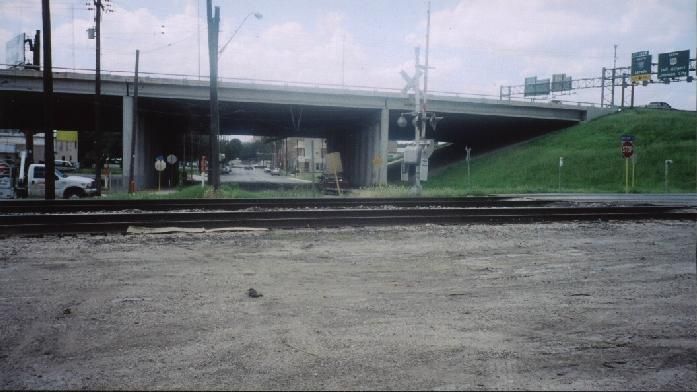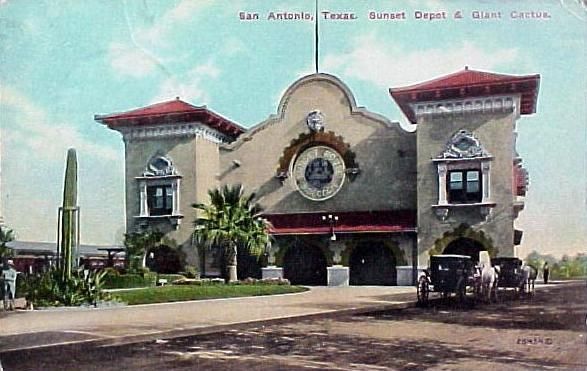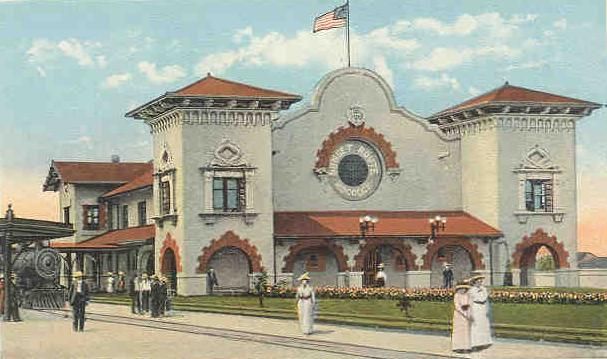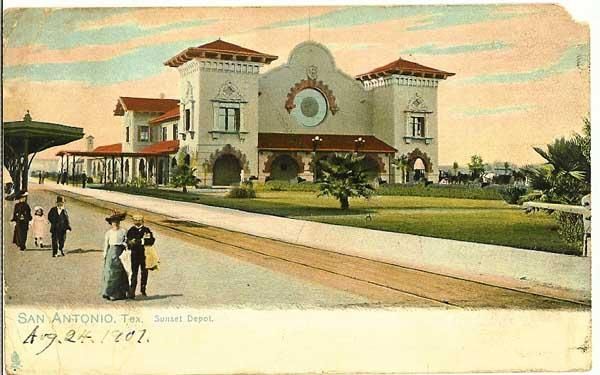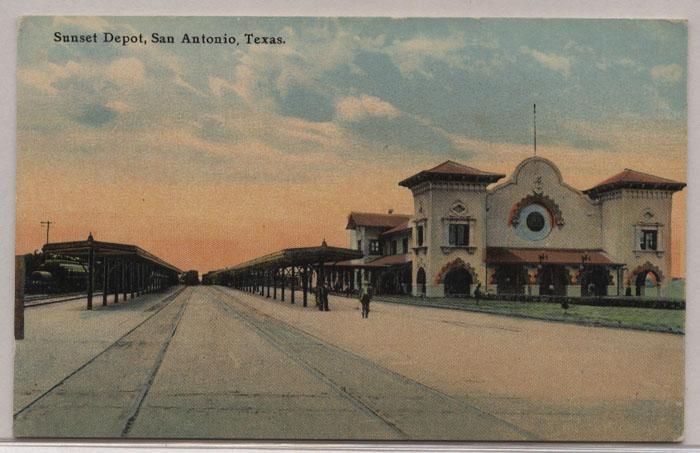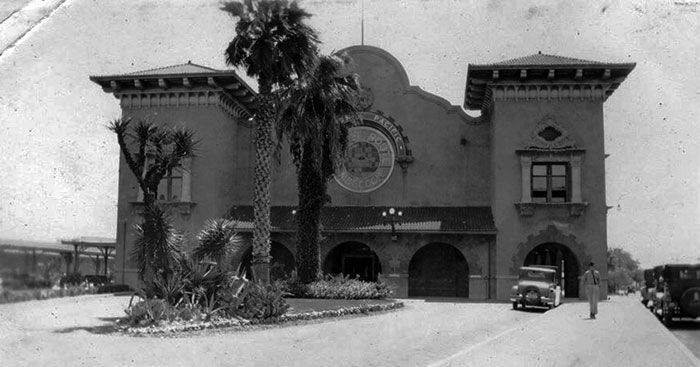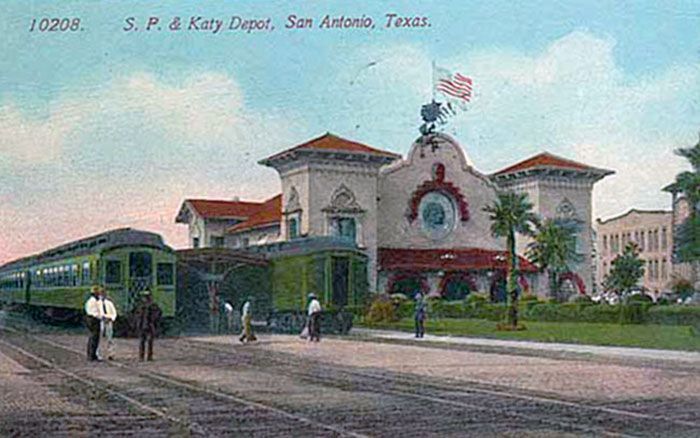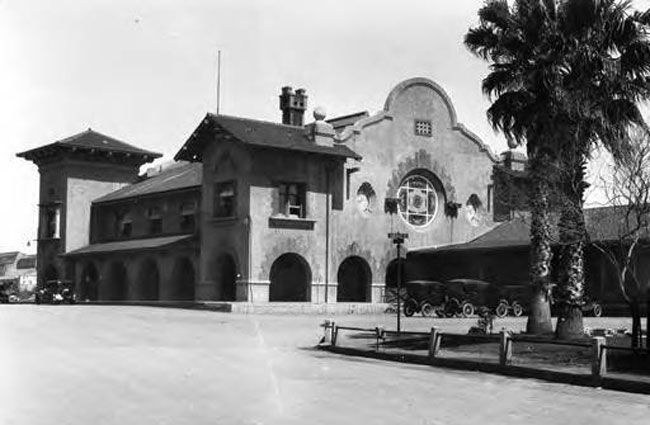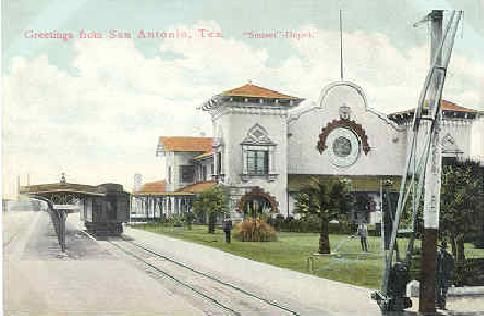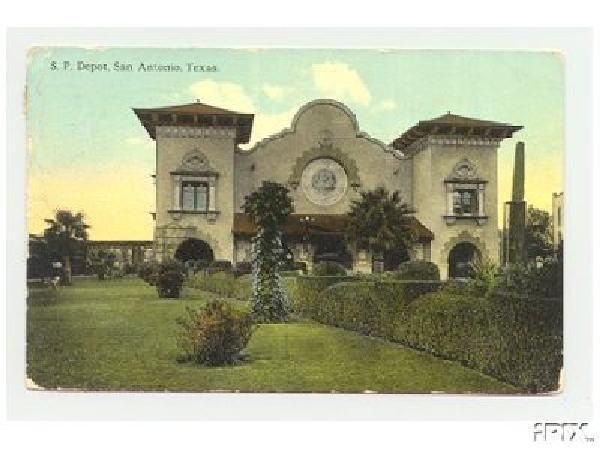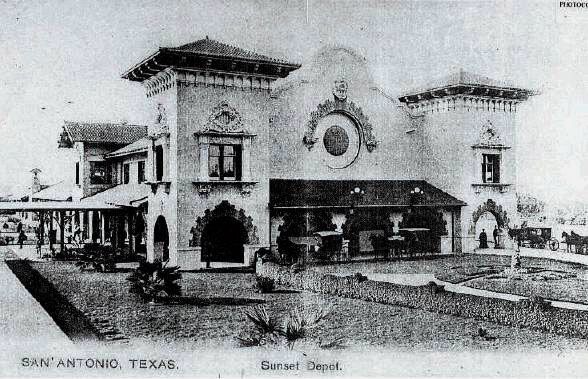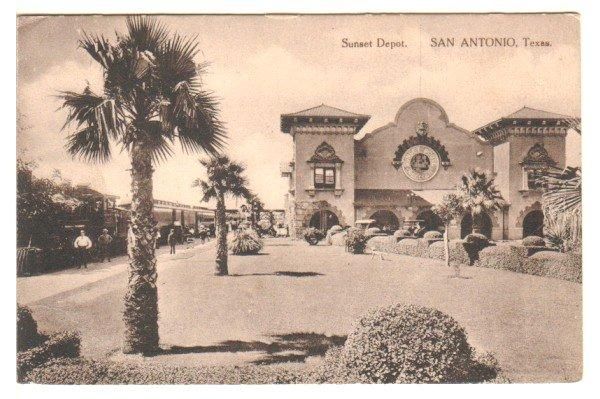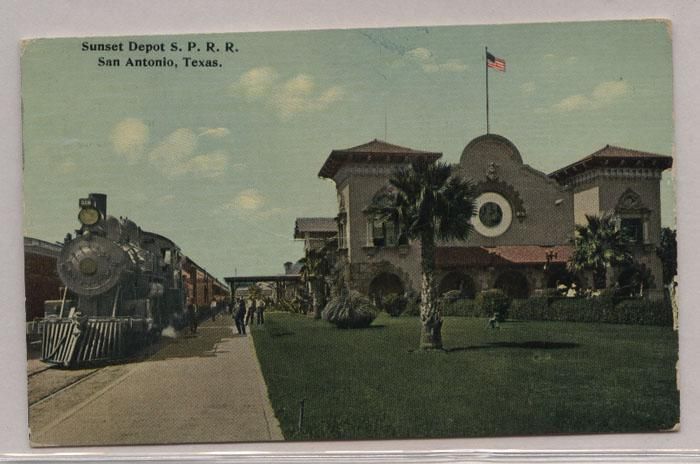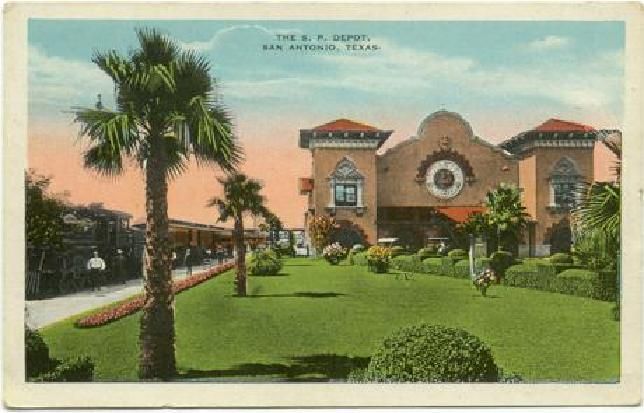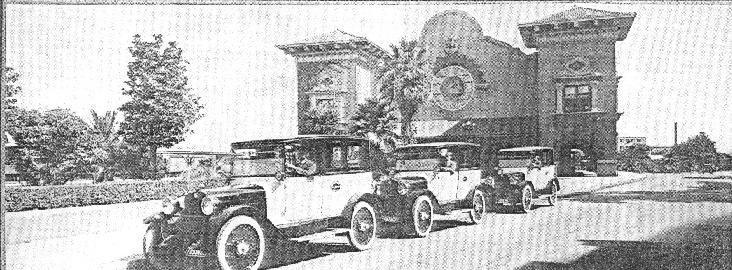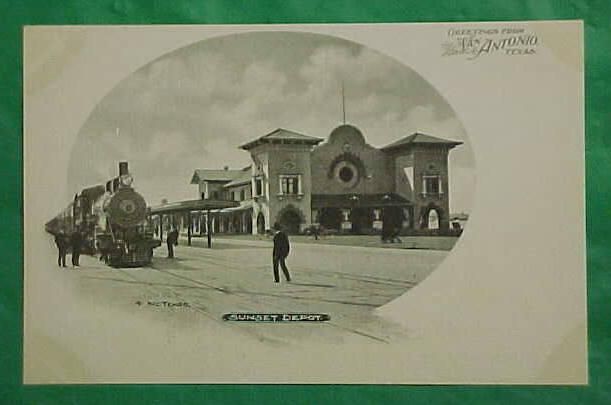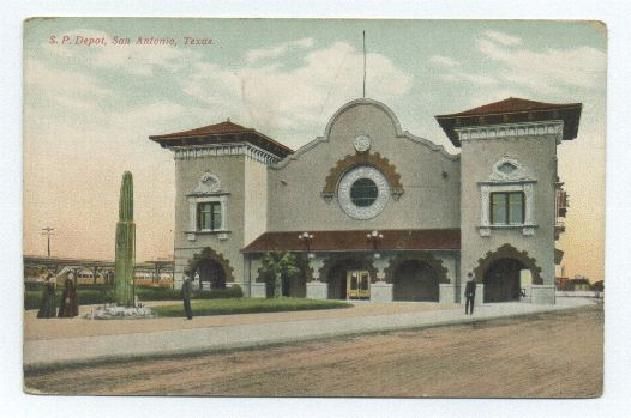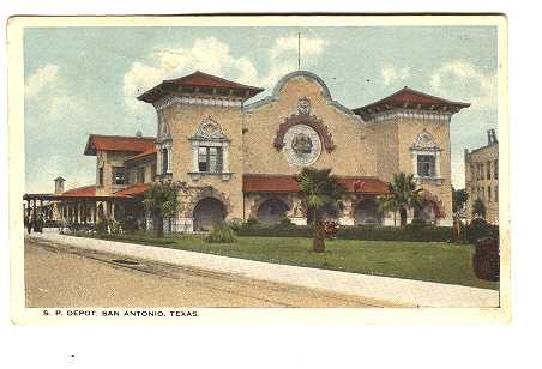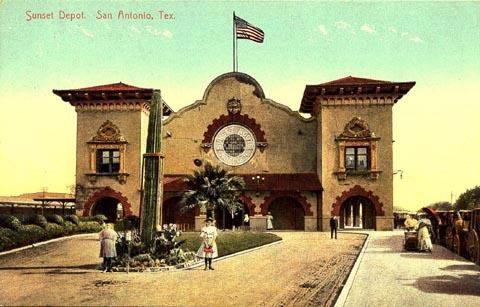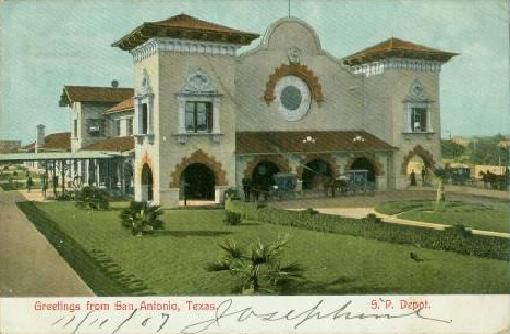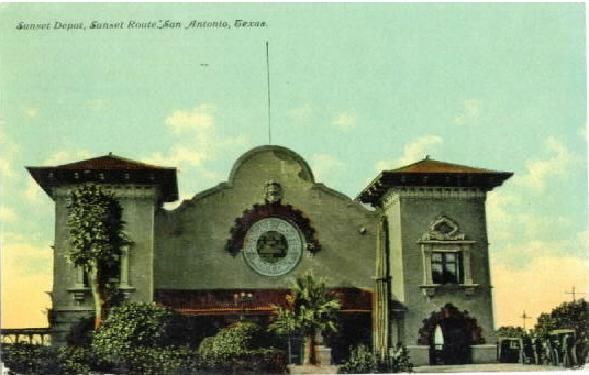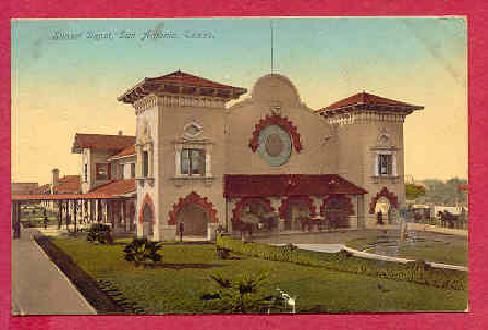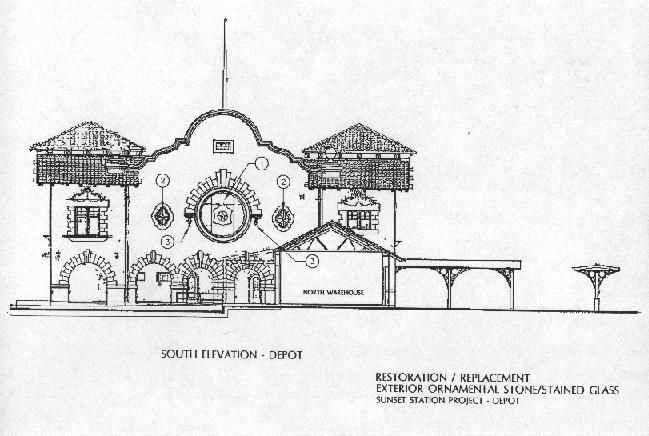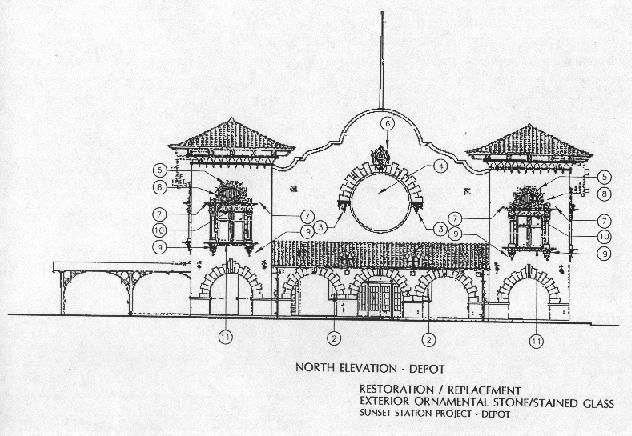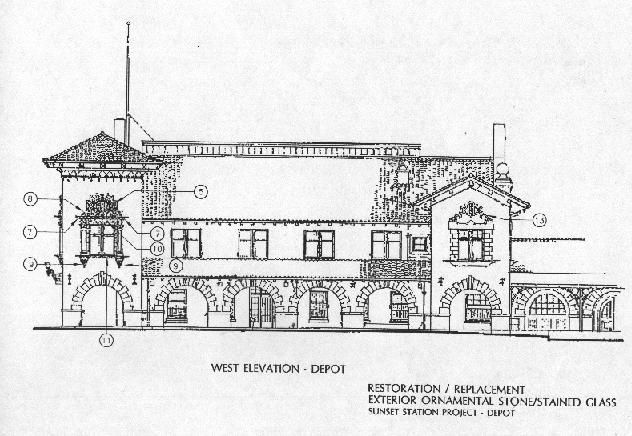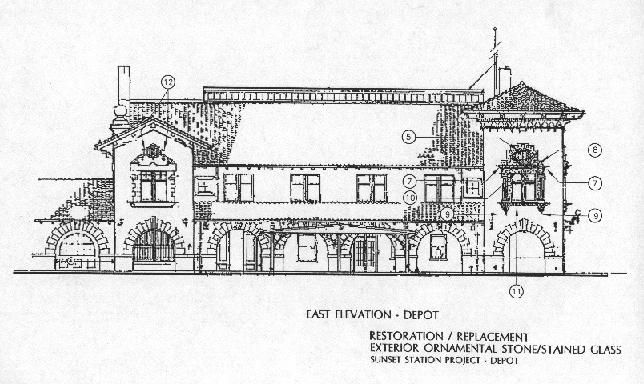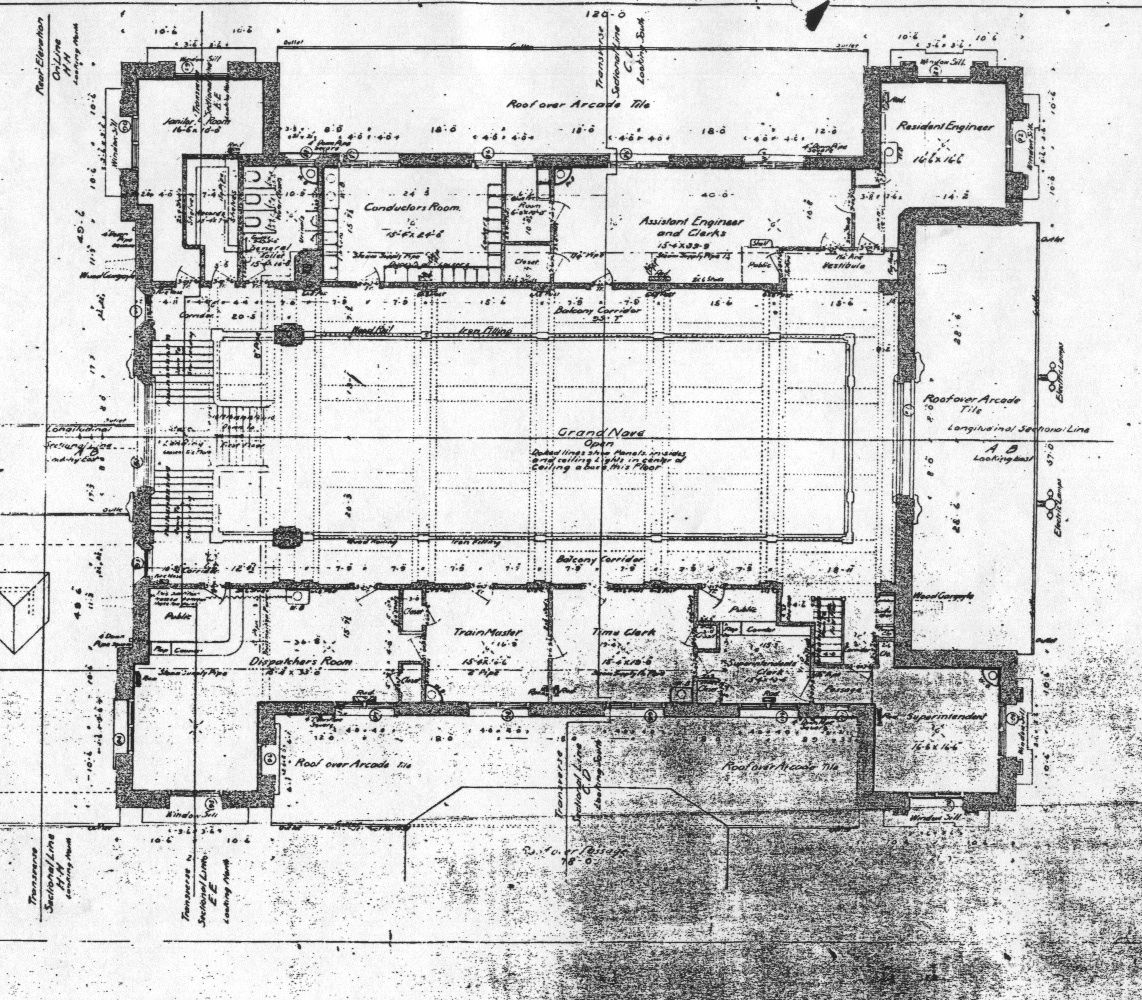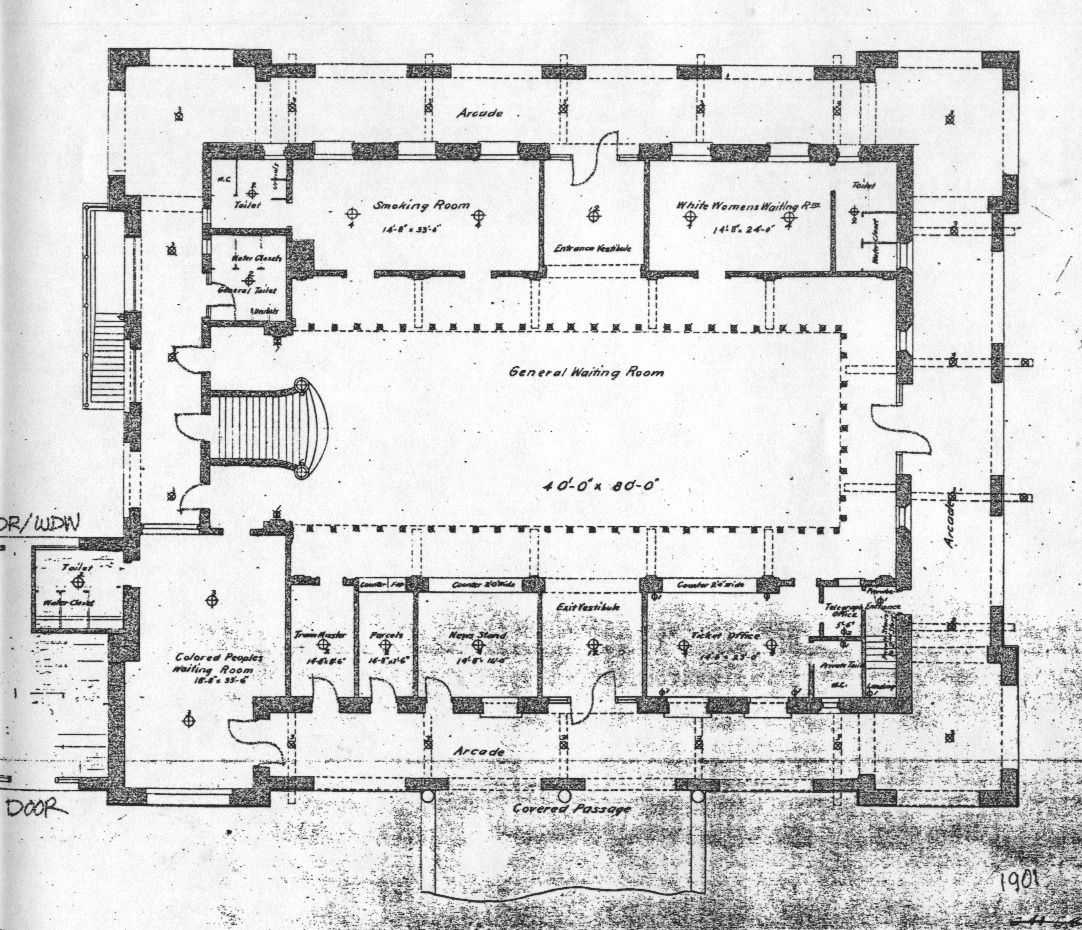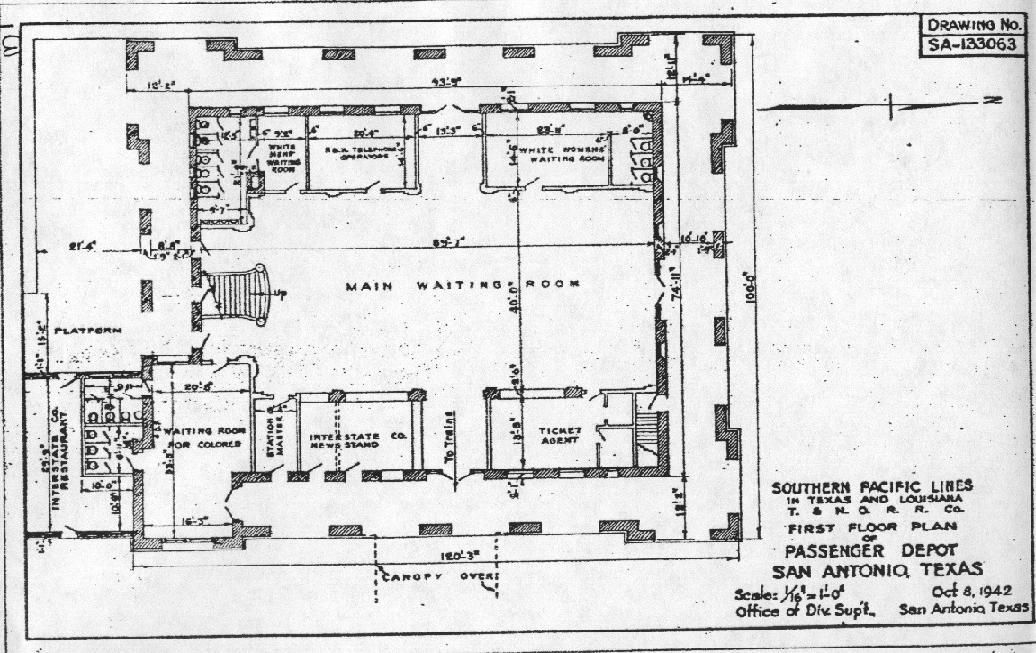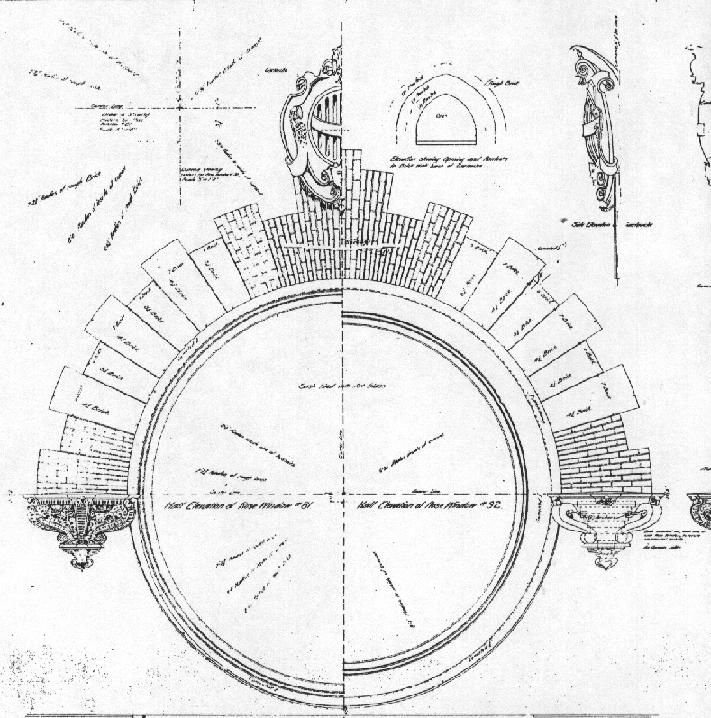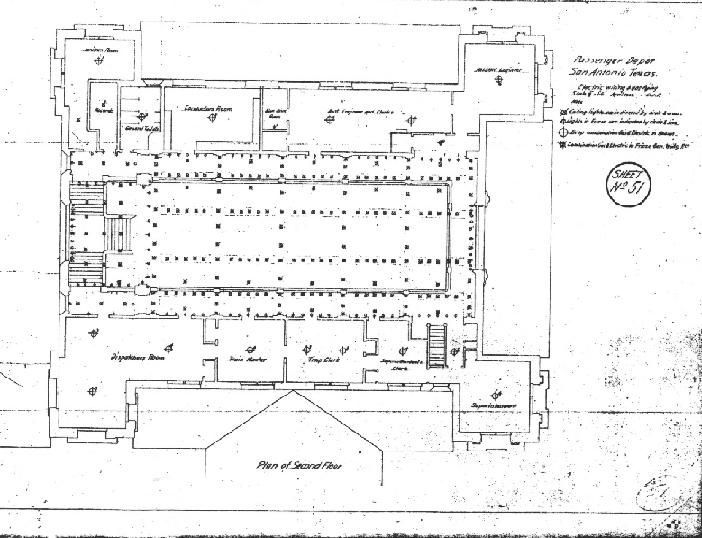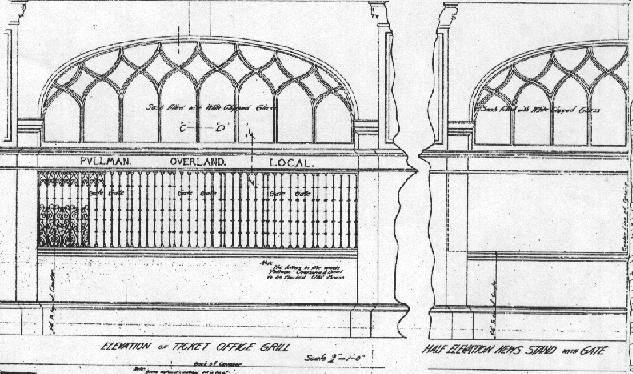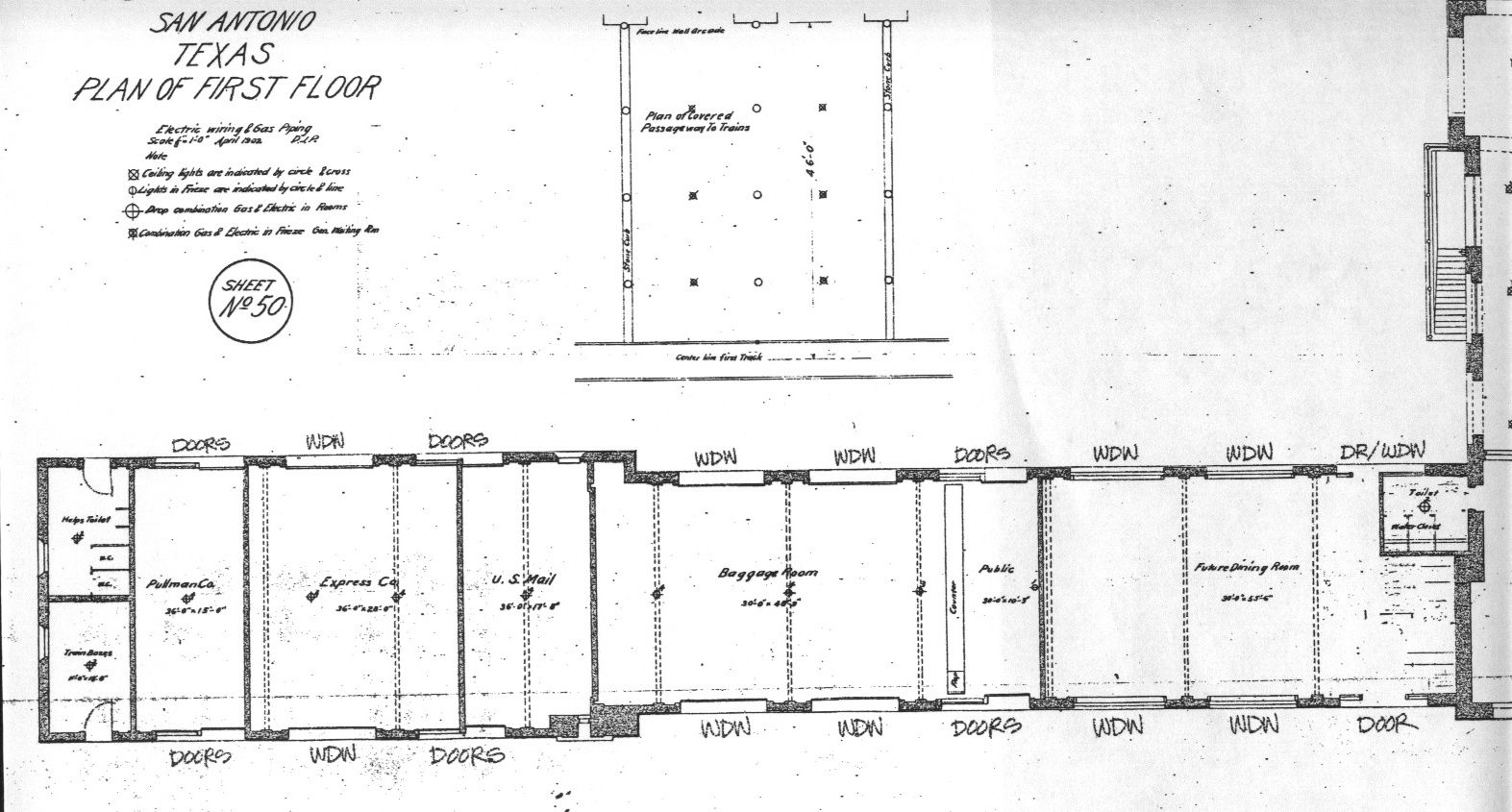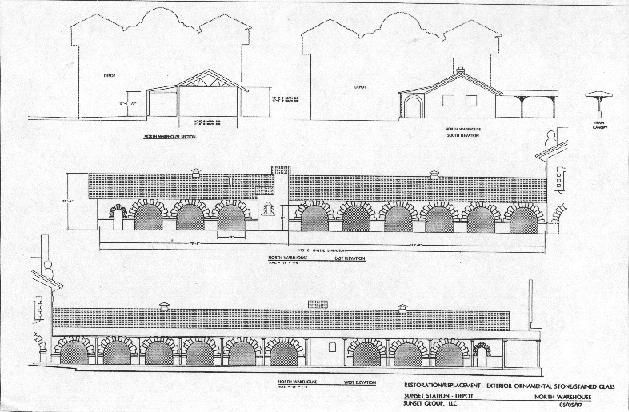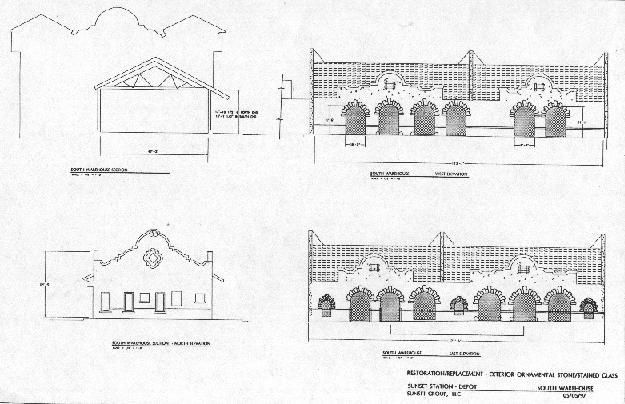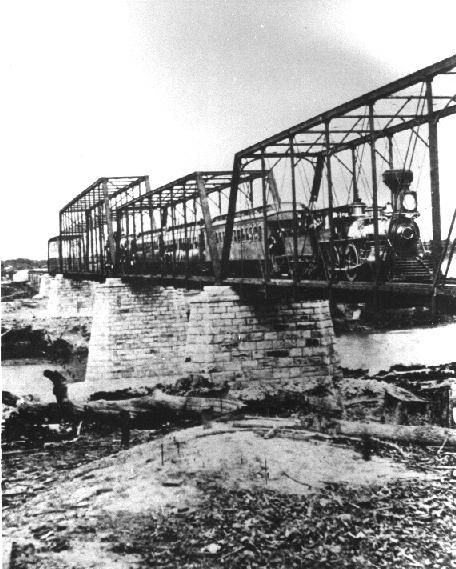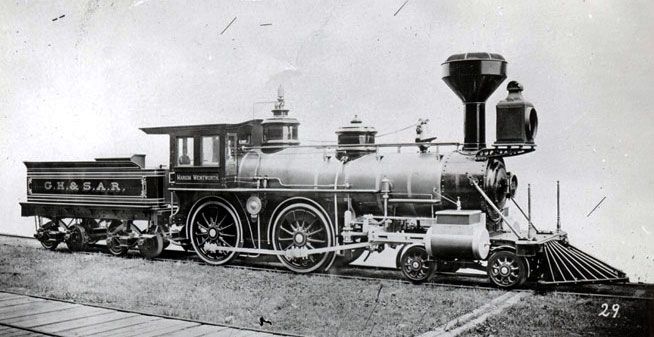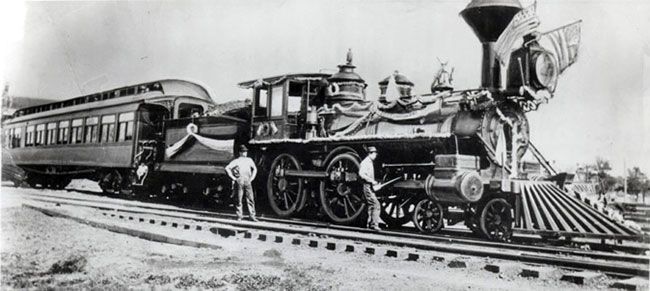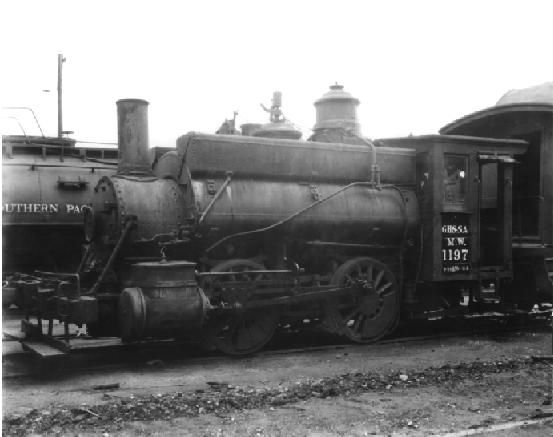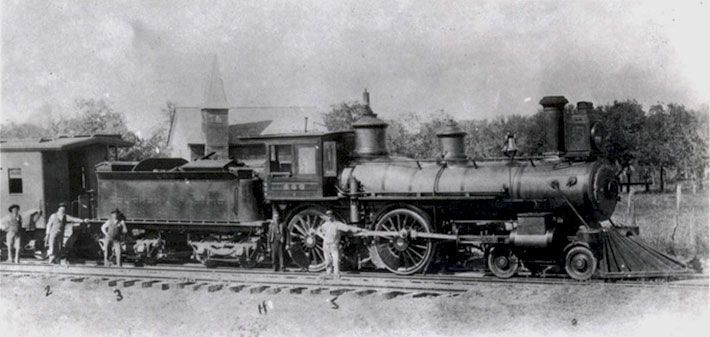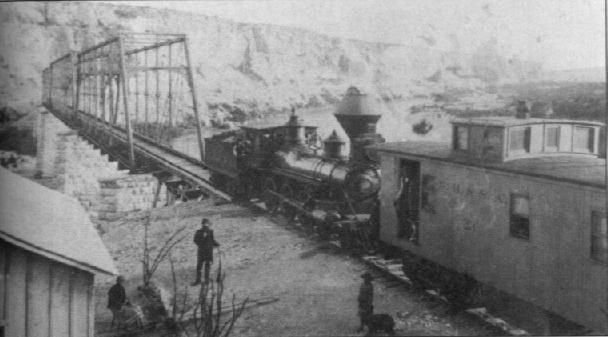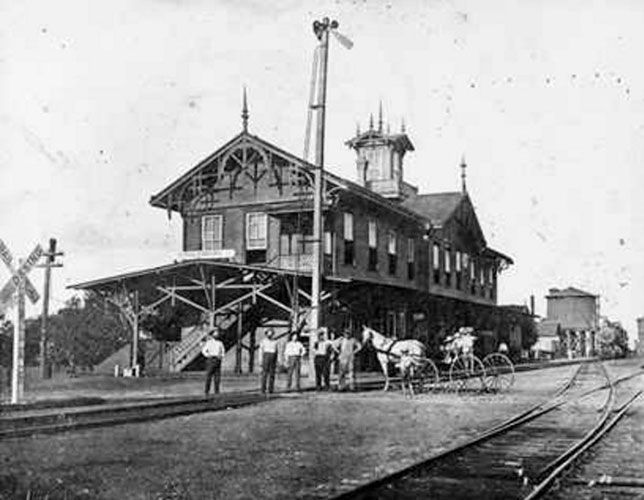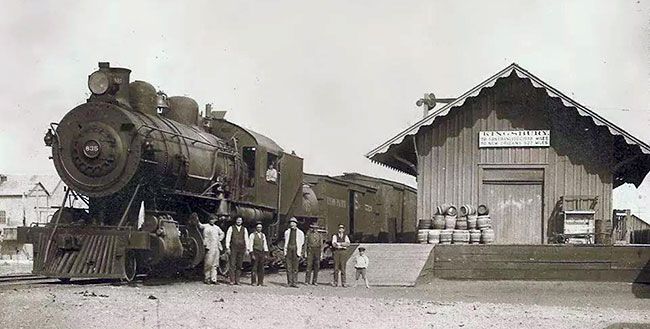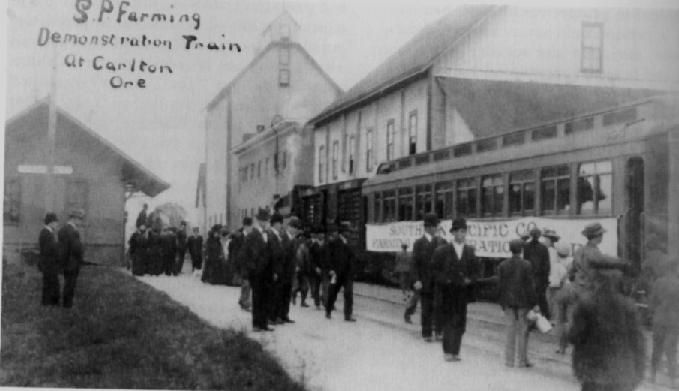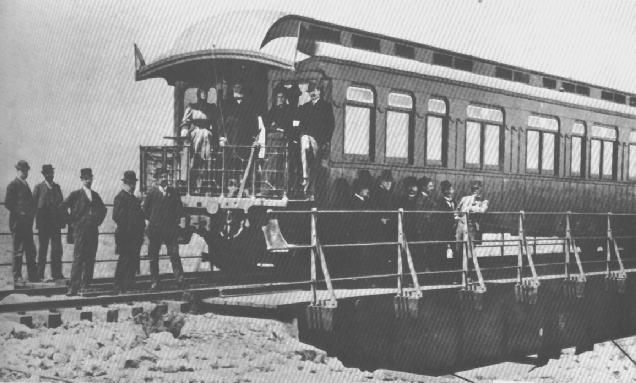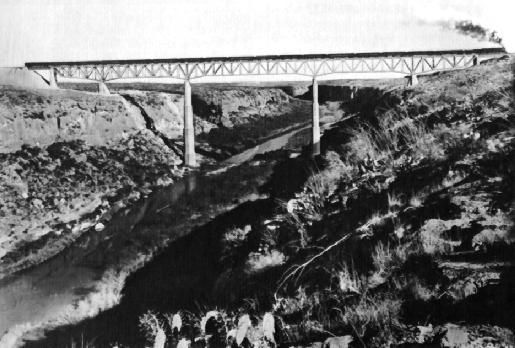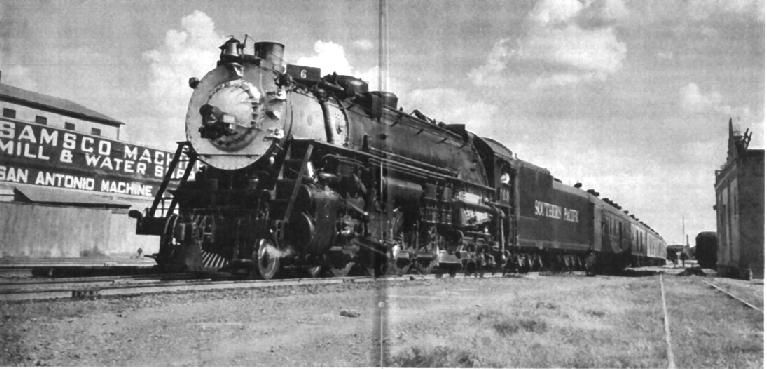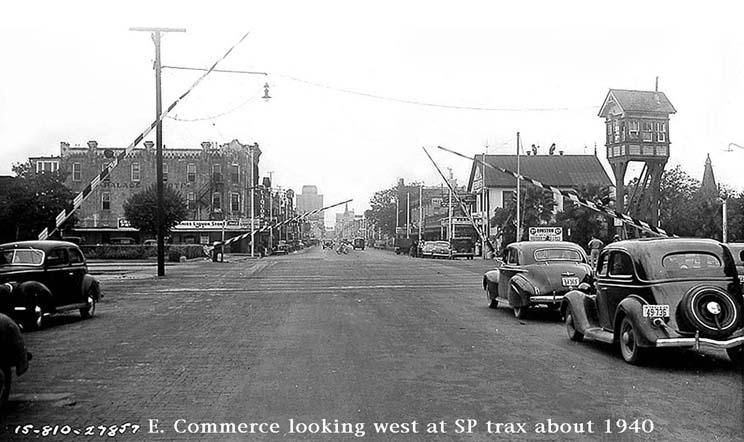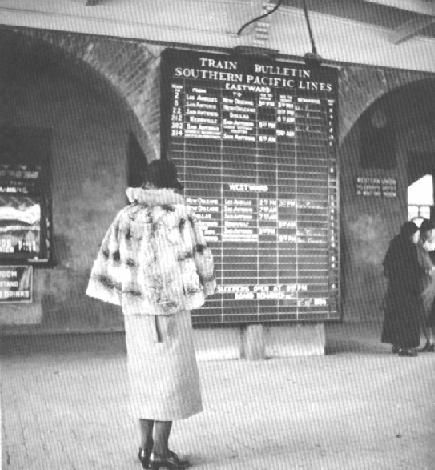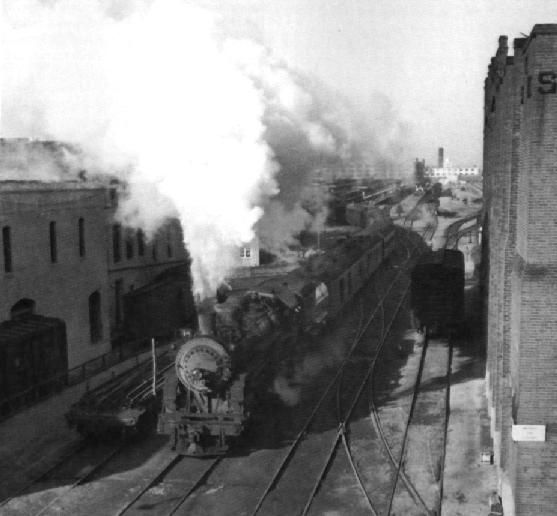Southern Pacific Railroad in San Antonio
and South Central Texas - Part 1
Sunset Station in San Antonio
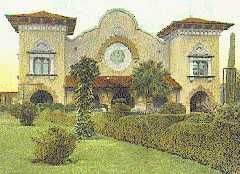
The museum is indebted to the Institute of Texan Cultures, the San Antonio Conservation Society, The Daughters of the Texas Republic, and the public libraries in San Antonio, Marion and Seguin for their generous assistance with this project. Each of these organizations maintain phenomenal archives and perform sterling service towards honoring the history of San Antonio and South Texas.
The museum is furthermore indebted to the generous cooperation of Ford, Powell & Carson, the architectural firm engaged to renovate the depot, and who ensured that this major landmark will continue into its second century in wonderful condition. Jeff Fetzer, who was involved in the project from the beginning, went out of his way to provide resources, perspective and insightful assistance, probably with the same spirit of enthusiasm, thoroughness and enjoyment he and the company brought to the whole endeavor.
In addition, we can hardly begin to express our thanks to the current custodians of the depot, The Sunset Station Group, LLC. This company has took on the responsibility of renovating the depot and poured untold millions of dollars into the project. They were extraordinarily respectful of the depot's history and are finding creative ways to expand on its heritage and not only keep the complex in its currently fully restored condition but to continue its use as a place for the whole city to use and be proud of. We are particularly obligated to Bruce Spencer, the indefatigable facilities manager, who brings an energy to his work that will ensure that the depot will be in public use for many years to come.
Early Days - The Buffalo Bayou, Brazos and Colorado Railroad which became the Galveston, Harrisburg and San Antonio
On February 16, 1877, rail service began in San Antonio. The celebrations that occurred in the city were magnificent. City leaders knew the future of the city depended on the railroad. The decline in San Antonio's population had been precipitous. Most developments were happening in the coastal cities and San Antonio's fortunate position as a crossroads on routes to the north, south, east and west would fade if the railroad could not amplify its significance. Over 8,000 people turned out to welcome the arrival of the Galveston, Harrisburg and San Antonio Railroad, including the governor, Richard B. Hubbard and Lt. Governor, Wells Thompson, along with the mayors of San Antonio, Austin, which had received rail service in 1871, and Galveston. The marching band of the 10th US Infantry, plus the US Cavalry and the Alamo Rifles also took part. It was noted during a speech that San Antonio was perhaps the largest city on the continent that had remained for so long without rail connections. The future of the city would now be infinitely brighter and secure.
1890, 1893 & 1941 GH&SA timetables, Sunset Limited adverts
On February 16, 1877, rail service began in San Antonio. The celebrations that occurred in the city were magnificent. City leaders knew the future of the city depended on the railroad. The decline in San Antonio's population had been precipitous. Most developments were happening in the coastal cities and San Antonio's fortunate position as a crossroads on routes to the north, south, east and west would fade if the railroad could not amplify its significance. Over 8,000 people turned out to welcome the arrival of the Galveston, Harrisburg and San Antonio Railroad, including the governor, Richard B. Hubbard and Lt. Governor, Wells Thompson, along with the mayors of San Antonio, Austin, which had received rail service in 1871, and Galveston. The marching band of the 10th US Infantry, plus the US Cavalry and the Alamo Rifles also took part. It was noted during a speech that San Antonio was perhaps the largest city on the continent that had remained for so long without rail connections. The future of the city would now be infinitely brighter and secure.
The first Galveston, Harrisburg and San Antonio railroad depot in San Antonio
By 1900, and for the next 30 years, San Antonio was the largest city in Texas. Galveston lost the number one position after a great storm inundated the entire island and caused immense loss of life and property destruction. Houston was yet to be developed and Dallas would not be a major city for several decades. More railroads were now serving San Antonio. The International & Great Northern came just a few years after the Galveston, Harrisburg & San Antonio, providing service to the north, as did the Missouri-Kansas-Texas Railroad. Although both the I & GN and the MKT were briefly under the common control of Jay Gould's Missouri Pacific, the M-K-T used the G.H. & S.A. station(s) until 1917, when they opened one of their own. In addition, a local railroad, the San Antonio and Aransas Pass was started and within a few years had reached Corpus Christi, allowing access to another deep water port. Business of all kinds was booming. Agricultural production was stimulated, older, smaller towns, and new ones too, were growing wherever the railroads built a depot. The population of San Antonio doubled from 1870 to 1880 to 31,000 people. The number of farms in the area quadrupled. Wool production alone climbed from 700,000 lbs. in 1870 to 7,000,000 labs by 1884. Factor in livestock, fruits and vegetables, plus other local production and you have an explosive growth in the economy, mainly created and supported by the railroads.
Not wanting to lose their pre-eminent position, the G.H. & S.A. decided to build a newer, grander station. A site was chosen eleven blocks to the south at Commerce Street. Not only was the building larger and infinitely grander, it was also much nearer down town. Most of the businesses that had grown up with and supported the old depot were offered preferential treatment to relocate near Sunset Station and most did. Before long, the old depot was demolished, and the whole area sank back to being just another quiet neighborhood. More tracks at this still sharp bend in the rails were added and the levee strengthened, obliterating any traces of the old depot. In the late 1950's, HWY 281 was built and now on the other side of Austin Street from the rail road tracks is another, even higher, embankment, for the freeway.
But what a magnificent station had taken its place. From its very first days in 1903, it was simply stunning. It was given the name of the route it served, the Sunset Station. Long before the route through San Antonio reached from Los Angeles to New Orleans, the line was known as the Sunset Route. It was based on a derogatory description of the old BBB&C's Service. It was said that if a person got on board the train in Houston at sunrise, you'd be lucky to get to Columbus on the Colorado rive by sun set. And the SP's logo was most likely based on a doodle by a bored office boy! The very first train to arrive in San Antonio years later in 1877 was already called the Sunset Limited, and the name grew with the route, extending all the way to California. Sunset Station was, and is still is, a masterpiece. Little expense was spared. The fore-runners to today's San Antonio Chamber Of Commerce, then known as the Business Club, supported the new station wholeheartedly. If this was going to be the first major building that many people saw in San Antonio, they would be sure to get a magnificent impression.
Interestingly, the station was designed by Southern Pacific personnel, not a "hired gun," as was the case with the I & GN / Missouri Pacific and the M-K-T depots. John D. Isaacs, an architect whose official title was Assistant Engineer of Maintenance-of Way for the Southern Pacific Company in San Francisco, California, can take the lion's share of the credit, along with his assistants D.J. Patterson and W.E. Milwain. Isaacs described the building as, "Worthy of note as being the best recent adaptation of the Mission style of architecture to modern requirements." He further stated that the Alamo had been his key point of reference. The station opened to the public on January 31, 1903, following an elongated period of construction that began in November 1901. Difficulties in acquiring all the needed materials for construction hampered progress. The total cost was $115,000.00, which is equivalent to $2,300,000.00 in today's (2002) money.
The two story main building contained the general waiting room, a smoking room or men's waiting room, a white women's waiting room, presumably non-smoking, and a colored people's waiting room at the rear with a separate entrance. The colored rest room facilities were enlarged in 1942. Also on the ground floor were trainmaster, ticket and telegraph offices, a parcel window and a newsstand. The main waiting area measures 40 X 80 feet. On the upper floors were offices for the Superintendant, dispatchers, clerks, the resident engineer, draftsmen and conductors. The upper floor could be accessed by the main grand staircase or an ancillary staircase tucked away in one corner. A walkway went around three sides of the upper floor with an ornate railing. The building is made of brick on a concrete foundation, mainly stuccoed except for exposed brick arches and jambs. The roof tiles are of red clay. When it was opened, the building was painted a soft yellow, or ochre, but this was changed to a soft pink somewhere around 1950.
One of the most notable features of the very ornate and colorful interior are the hundreds upon hundreds of original and restored incandescent lighting fixtures. What a stunning impression they must have made back in 1903, when most people did not have electricity. Both the front window which has the magnificent Sunset medallion and the rear window which has the Seal of the State of Texas are surrounded by these lights. In addition to electricity, there was also gas lighting. Some people have speculated it was the early electrical wiring that led to an almost catastrophic fire in 1907. The roof was destroyed and its steel trusses collapsed into the main waiting area. Damage was estimated at $25,000. The robustness of the original structure was proven, and the structure needed little in the way of repairs. The palm trees that decorated the interior and the exterior flower beds were not so lucky, of course. Repairs took longer than expected, due once again, to the shortage of appropriate materials. Other spaces such as the dining room were pressed into alternative service until the repairs were complete.
The main building, also known as the head house, had a one story extension that contained the dining room, service room, baggage rooms, plus offices for Wells Fargo, the post office and the Pullman Company. Wells Fargo relocated to an additional building some 70 X 100 feet, built at the south end on the extension in 1909. This building, intended for heavy express freight, was doubled in size sometime between 1931 and 1938. Other than that, alterations and additions to the building have been minimal. A projecting shade canopy was added along the entire extension on the non-track side around 1922. Air conditioning and additional offices were installed around the time AMTRAK took over the building in 1970, as A/C had never been an original feature of the depot. Pictures show a variety of landscaping around the front of the building but there always was a driveway right up to the front door for taxis and other vehicles.
The Galveston, Harrisburg and San Antonio Railroad, the first railroad to arrive in San Antonio, has a wonderful pedigree and history all of its own. It is also prudent to mention even here its association with the Southern Pacific is almost as old as the company itself. The G.H. & S.A. began, logically enough, in Galveston, which was then the largest city in Texas and which was keen to see its port facilities grow. Connecting to the rest of the world via rail was the only expedient way to go in the 1850's and any number of railroad companies were formed, many of which were very successful. You would have difficulty finding Harrisburg on a modern map today, but the Harris name lives on as the name of the county, while the city itself was absorbed by Houston and is now just one of it's many districts. In 1870, the G.H. & S.A. arose like a phoenix from the post civil war ashes of the Buffalo Bayou, Brazos and Colorado Railway Company which was chartered in 1850 and was the first railroad to operate in Texas. The BBBC was founded by General Sidney Sherman, who is credited with coining the phrase, "Remember the Alamo!" at the battle of San Jacinto. The first locomotive owned by the BBBC was named, "The General Sherman." If you cannot find the Buffalo Bayou on a modern map, look instead for the Houston Ship Canal, which is what it was developed into. In 1870, Thomas W. Pierce gained control and the company was renamed. While other railroads were setting off for Louisiana, Dallas and Austin, the G.H. & S.A. set its sights on San Antonio.
New construction from Columbus, 125 miles east of San Antonio, which the railroad had already reached via its own construction and the acquisition of other railroads, began in 1873, under the leadership of Major James Converse, after whom one of the towns that would spring up along the way would be named when he acquired land there for himself. Stops along the route from Houston were Pierce Junction, after 8 miles, Stafford, another 20 miles, Walker, 5 miles on, then Richmond, 6 miles, Random, 10 miles, East Bernard, 10 miles, New Philadelphia, 16 miles, Eagle Lake, 8 miles, Alleyton, 12 miles, to Columbus, another 4 miles. Progress continued to Borden, 10 miles, Weimar, 6 miles, Schulenburg, 9 miles, which was reached by the summer of 1874. Then onto Flatonia, 12 more miles, Waelder, 13 miles, Harwood, 13 miles, Luling, 9 miles, and Kinsbury, another 12 miles, which was reached by the summer of 1875. Then onto Seguin, 9 more miles, Marion, 7 miles, by the spring of 1876. Then onto Converse, whose second depot is now located at the museum, another 18 miles, then Upson, another 8 miles and finally, on February 5, 1877, San Antonio, another 5 miles on.
By now Pierce was in sole charge of the G.H. & S.A. The line to San Antonio was already called the Sunset route, although it was often also called the Pierce Line as well. With foresight, he had acquired the rights to continue building west, all the way to El Paso. This was done in collaboration with Collis P. Huntington, of the Southern Pacific, who had been showing interest in the line for several years. The Southern Pacific's goal was very simple. They wanted to build a second transcontinental line to New Orleans, Louisiana, the nearest Atlantic port to the fledgling State of California. It is worthwhile to note that when California became a state, it had no other states around it, only territories, and the Panama Canal was yet a dream. Establishing a more direct route solely under their control would be of enormous benefit to both the S.P. and the whole state of California, and work towards the east through what is now Arizona and New Mexico had already begun by 1880, when the G.H. & S.A. began to survey a route to El Paso. Although work had hardly begun west of San Antonio on what was being called the Sunset Extension, the S.P., building eastward from California, had already reached El Paso by May of 1881. Lacking permission to continue working towards San Antonio, the same crews continued on across Texas, with the simple expedient that they were now employees of the G.H. & S.A. In case you had forgotten just how big Texas is, the crews working from both directions did not meet up until January, 1883, at a point just west of the Pecos river, some 225 miles west of San Antonio. Pierce drove home a ceremonial spike on January 12, 1883. The route would be shortened and the original Pecos bridge replaced, creating the highest rail bridge in the USA. Sections of the old route, that involved descending much further to cross the river, are well marked within a state park near the river.
The S.P. had officially acquired an interest in the G.H. & S.A. in July of 1881. As well as building towards El Paso, the G.H. & S.A. was building a variety of branch lines, to La Grange, and Eagle Pass, plus others. Some of the terrain to be traversed was very difficult for railroading but such was the spirit of the times and what, anyway, was the alternative? The G.H. & S.A. was officially leased to the Southern Pacific by mid-1889, although it continued to be independently controlled, As well as continuing to build its own lines, it also acquired and merged with five other local carriers, such as the San Antonio and Gulf. Although it too had been effectively part of the S.P. for decades, the San Antonio and Aransas Pass Railroad was not officially merged into the G.H. & S.A. until January 1, 1925. On March 1, 1927, the G.H. & S.A. was leased to the Texas & New Orleans Railroad Company, which had become the S.P.'s main railroad division in Texas. At that point the G.H. & S.A. actually controlled 1,345 miles or 40% of the S.P.'s holdings in Texas in comparison to the T. & N.O.'s 20%, but the latter, operating out of Houston, was seen by the S.P. as its central point of control for the state. In all the S.P. took over some one hundred railroad companies in Texas, and its web spread out across the entire state. As its California business grew and the Panama canal made sea access to California much faster, relations with the eastern part of the empire were not always easy, but the system was very robust and had an enormous economic impact wherever it went.
As stated, the Southern Pacific empire took over some one hundred independent railroad companies in its desire to reach New Orleans. Texas law mandated that railroads operating in Texas must be owned and controlled from within Texas. Before 1927, most of the former independents had been consolidated into three main companies, which were the Texas & New Orleans, which would be chosen as the predominant company and headquarters for S.P. operations within the state, the Galveston, Harrisburg & San Antonio, which had built most of the lines between Houston and El Paso, the Houston and Texas Central, which has reached Dallas in July of 1872. Each of these three were composites of any number of smaller companies by 1927. The T & N.O. leased the G.H. & S.A. and the H. & T.C. in 1927 and everything was completely merged in 1934. By 1928 the system comprised of 3,966 miles. With the acquisition of more railroads, such as the Cotton Belt, formally known as the St. Louis Southwestern Railway Company, in 1932, the system's reach had assumed truly vast proportions.
Southern Pacific in San Antonio Timeline
━━━━━━━━━━━━━━━━━
1850
The Buffalo Bayou, Brazos and Colorado is chartered. The BBB&C is the 1st railroad in Texas
━━━━━━━━━━━━━━━━━
1865
The Southern Pacific is formed in San Francisco, California
━━━━━━━━━━━━━━━━━
1870
Thomas Pierce, a trader in Texas products from Boston, takes over the bankrupt BBB&C
━━━━━━━━━━━━━━━━━
1873
Following the offer of a $500,000 bonus from the city of San Antonio, the BBB&C is renamed Galveston, Harrisburg & San Antonio. Construction of a bridge over the Colorado river at Columbus begins.
━━━━━━━━━━━━━━━━━
1877
Feb 2. 1st ever railroad train arrives in San Antonio. The GH&SA RR tracks stop at Hays Street
Feb 15. 1st freight delivered, a car load of lumber for J.H. Kampmannt
Feb 19. The line is formally opened
━━━━━━━━━━━━━━━━━
1881
Under Southern Pacific (SP) control, the GH &SA begins building towards the west
━━━━━━━━━━━━━━━━━
1883
GH&SA tracks meet SP tracks built from California 225 miles west of Texas near the Pecos river creating the nation's 2nd transcontinental service, the only one totally under the control of one company. 1st passenger and freight trains arrive from San Francisco.
Wells Fargo opens its first express office in San Antonio
━━━━━━━━━━━━━━━━━
1890
Somewhat in contravention of state law, the SP gains effective control of the bankrupt San Antonio & Aransas Pass RR
━━━━━━━━━━━━━━━━━
1891
Traveling from New Orleans to California by rail, Benjamin Harrison is the first sitting US President to visit San Antonio. This visit is the catalyst for the annual "Battle of Flowers.
━━━━━━━━━━━━━━━━━
1893
The SP begins operating the coast to coast Sunset Limited train. It later evolved into a 1st class only train. Still going today under AMRAK, it is the oldest continuously operated train in the USA
━━━━━━━━━━━━━━━━━
1897
The SP acquires the bankrupt San Antonio & Gulf Shore, renames is the San Antonio & Gulf
━━━━━━━━━━━━━━━━━
1901
The MK&T builds its own tracks into San Antonio, shares SP depot
━━━━━━━━━━━━━━━━━
1903
Sunset Station is opened
━━━━━━━━━━━━━━━━━
1907
Head House at Sunset Station suffers damage from an electrical fire
━━━━━━━━━━━━━━━━━
1909
Wells Fargo opens a building at the rear of Sunset Station for its freight business
━━━━━━━━━━━━━━━━━
1912
The worst locomotive boiler explosion in US history happens during at the San Antonio SP round house
━━━━━━━━━━━━━━━━━
1917
The MK&T opens its own railroad station but maintains close ties with the SP
━━━━━━━━━━━━━━━━━
1925
The San Antonio & Aransas Pass is fully merged into the GH&SA division and is downgraded to 2nd class status
━━━━━━━━━━━━━━━━━
1926
The SP inaugurates its second, slower, less expensive, transcontinental train, the Argonaut
━━━━━━━━━━━━━━━━━
1927
The GH&SA division is merged into the statewide Texas & New Orleans division of the SP
━━━━━━━━━━━━━━━━━
1931
Wells Fargo freight building is expanded
━━━━━━━━━━━━━━━━━
1932
The SP reports its first annual loss but survives the Great Depression without declaring bankruptcy, one of the few major lines to do so
━━━━━━━━━━━━━━━━━
1940
In anticipation of WW2, the SP begins working with the military to avoid the issues that caused gridlock during WW1. These efforts allowed the system to run well throughout the war.
━━━━━━━━━━━━━━━━━
1942
Segregated rest rooms for colored people are enlarged
━━━━━━━━━━━━━━━━━
1944
The SP acquires its last steam locomotive
━━━━━━━━━━━━━━━━━
1947
Diesel-electrics are introduced for main line service
━━━━━━━━━━━━━━━━━
1948
Harry Truman presidential campaign makes stops in Uvalde and San Antonio
━━━━━━━━━━━━━━━━━
1953
Piggy back service, a forerunner to modern containers, begins
━━━━━━━━━━━━━━━━━
1957
SP steam locomotive 794 is donated to the San Antonio Chamber of Commerce. A sister locomotive is given away in Austin
━━━━━━━━━━━━━━━━━
1958
All local passenger service from San Antonio is abandoned
The former San Antonio & Gulf Shore Line bet wen San Antonio and Cuero is abandoned
━━━━━━━━━━━━━━━━━
1971
AMTRAK takes over Sunset Station, adds A/C, destroys large SP "Sunset" logo at front of the building in the process
The old SA&AP line to Kerville north of Camp Stanley is abandoned
━━━━━━━━━━━━━━━━━
1996
The Southern Pacific is acquired by the Union Pacific
AMTRAK is asked to leave Sunset Station. Following a painstaking restoration, the complex of building opens as an entertainment venue
━━━━━━━━━━━━━━━━━
1998
The former SA& AP line from San Antonio through Floresville is abandoned
The former SA& AP line between A quarry at Loop 1604 and Camp Stanley is abandoned
Transportation Museum
CONTACT US TODAY
Phone:
210-490-3554 (Only on Weekends)
Email:
info@txtm.org
Physical Address
11731 Wetmore Rd.
San Antonio TX 78247
Please Contact Us for Our Mailing Address
All Rights Reserved | Texas Transportation Museum
